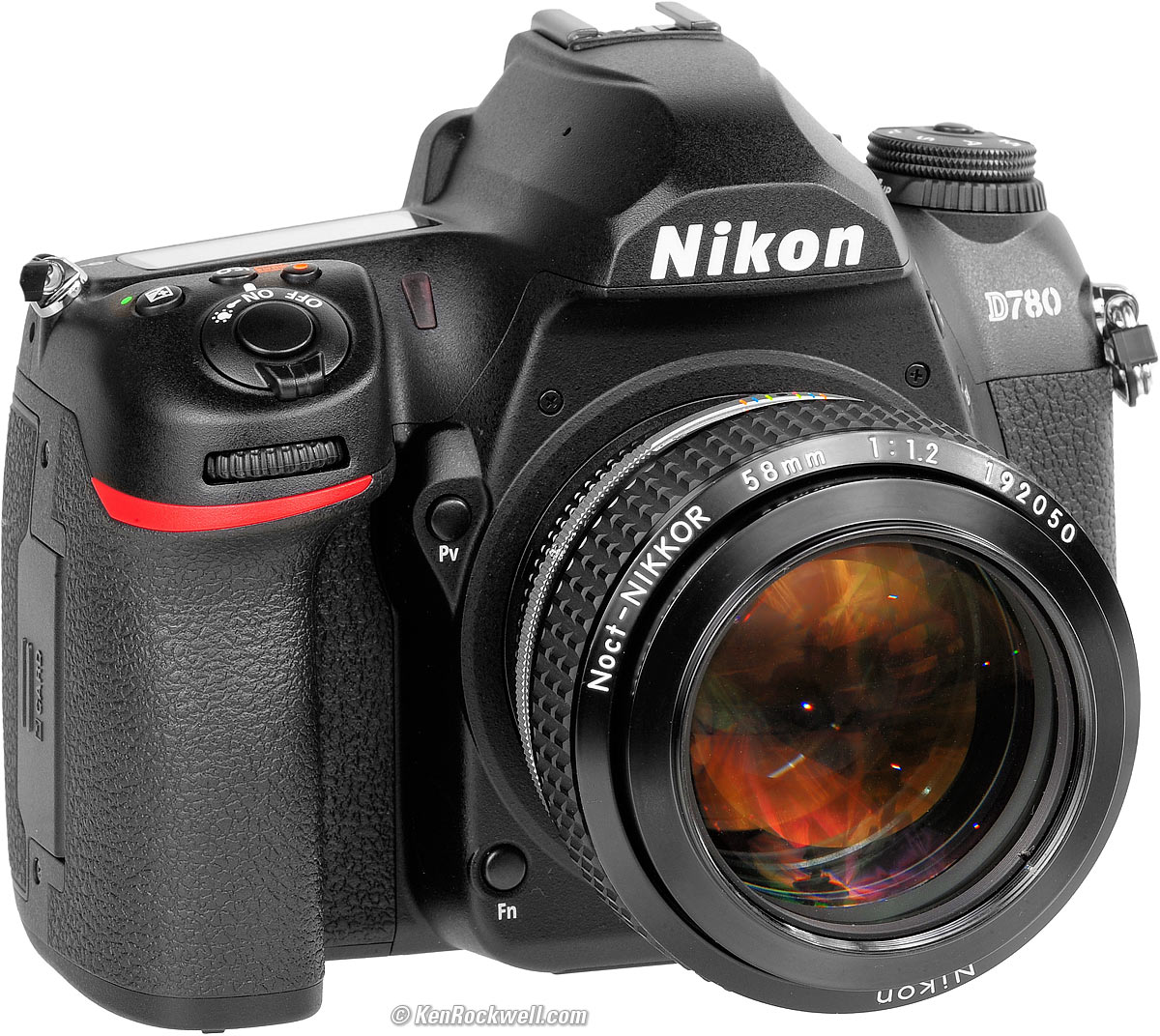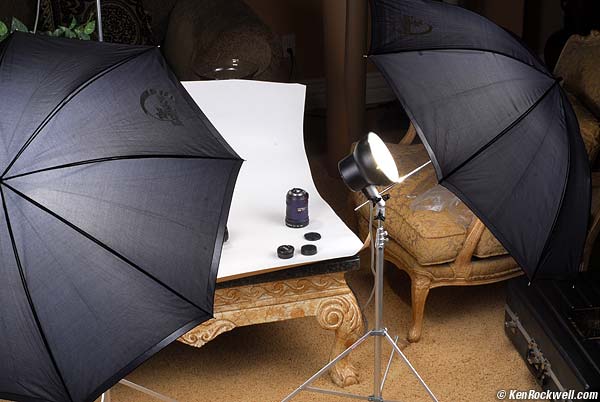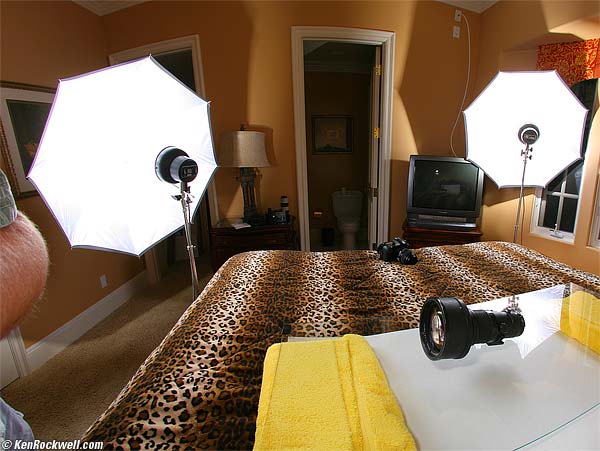Product Photography
Nikon D780 and Noct-NIKKOR 58mm f/1.2 AI-s shot with these techniques with my Novatrons, my AF Micro-NIKKOR 200mm f/4 D ED and my Nikon D3. bigger.
DEAL: $499 for a complete three-light 600 Ws strobe kit.
DEAL: $529 for a complete three-light 900 Ws strobe kit.
DEAL: $699 for a complete three-light 1,200 Ws strobe kit.
All of these 600 Ws (200 Ws × 3), 900 Ws (300Ws × 3) and 1,200 Ws (400 Ws x 3) kits have more than enough power for tabletop product shots. I've used a 500 Ws (total) kit for all my work for over 20 years, including the portraits above. The first two kits cost about the same and you can vary the power with all of these, so you may as well get the 900 Ws version. All of these new-for-2023 kits has LED modeling lights.
DEAL: $949 for a complete three-light 1,800 Ws (600 Ws × 3) strobe kit.
This kit offers even more power for working at longer distances or with larger groups of people. This older set uses hotter 150W halogen modeling lights, but I'll bet you you can swap-in household LED bulbs just as I did into my 1990s-era Novatrons.
You can buy all the power you want, but for tabletop and headshot use I find 500 Ws (total) to be perfect, so any of these kits is more than enough power for any household use.
This all-content, junk-free website's biggest source of support is when you use these or any of these links to approved sources when you get anything, regardless of the country in which you live. Thanks for helping me help you! Ken.
April 2023 Better Pictures Canon Nikon Sony Fuji OM SYSTEM LEICA Zeiss HASSELBLAD All Reviews
|
|
Introduction
I never thought much of it, but people ask me how I make my product photos look so good.
It's all in the lighting!
Here's how.
See also Studio Strobes and How to Use Studio Lighting.
Cleanliness
We'll be shooting small items and see them bigger-than-life on screen. Any dust, schmutz or fingerprints will become obvious.
It's faster to clean the items beforehand than to retouch them in Photoshop.
I always wear medical exam gloves to prevent leaving my own fingerprints.
I use fuzzy microfiber towels to suck off any dust or other people's fingerprints. I use these towels on the glass and bodies of everything.
Even brand-new items often need cleaning. I shoot in a class 10,000 clean room and pull the items out of the boxes only after I'm in the clean room and in my clean-room bunny suit.
Be as clean or as sloppy as you like. You'll have to balance your investment in cleanliness against the time you'll spend spotting all the dust and dirt later in Photoshop.
Background
Use heavy white paper. You can buy it on rolls. I don't.
I grabbed some big flexible sheets of the thin cardboard that served as disposable liners between stacks of toilet paper on the pallets at Price Club (Costco)! My wife thought I was nuts (and still does) for me bringing these home. These sheets are white on one side. I roll them up and carried them out with me. You don't have to go to Costco. Use anything that's white.
I unroll them to use as a white cyc (cyclorama) when shooting. It's easy: put it flat on a table. Put the product on the white sheet. Curve the back of the cardboard up behind the product. I rest the paper on my wife's metal elephant planter that sits on the table. This is easy; it's not nuclear weapons design.
Lighting
Forget battery-powered flash. The only people who suggest that are the camera makers like Canon and Nikon who hope you don't discover real studio strobes, which cost less, work better, and are much easier to set up and use.
You don't have to buy strobes. You can build your own lighting from work lights. It's a pain, but you can build what you need for under $100. Some people make a tent of white stuff and shoot through a hole.
Basic setup: no product support. (back light is on stand at left.)
Use lots of soft light. I just happened to luck into a set of used Novatrons (How to Win at eBay). I bought all this lighting gear for $550 used back in 2001 and still use it everyday today in 2020.
I use two umbrellas, one on each side. Keep them close for the most diffuse light. Keep them low to fill in underneath the product otherwise you may get dark shadows. Shadows make it tougher to clip the image away from the white background.
I use a third bare light above and slightly behind the subject to light the top of the product and the backdrop. This helps give it shape.
See Studio Strobes for more information about these strobes, and How To Use Studio Strobes for more on how to use them.
Since I drop out the white background, shadows make Photoshop selections a pain. Therefore I use a sheet of glass (pulled from a dumpster) supported with two pillows to eliminate shadows. Now the object is elevated above more white. Better is to object on opal (frosted) glass lit from below, but that's more lights and more work, but makes it easier to drop out the background later.
Product supported on glass for no shadows. (shot of the Nikon 300mm F/2.8 ED-IF setup made with fisheye lens and Hemi plugin.)
This setup shown wasn't very good because the leopard-print and yellow towels kicked yellow and orange onto the product.
I now pull the subject right up to the lights and support the glass with white boxes.
Light is art. Keep moving everything around until it looks great.
Camera, Lenses & Focus
I use an AF Micro-NIKKOR 200mm f/4 D ED on a Nikon digital SLR. On Canon use the Canon 180mm Macro. If you have a point-and-shoot digital, zoom it all the way to telephoto if you can get close enough. You want a longer lens because products look weird if you have to get too close.
I focus manually. It's easier than trying to twiddle with autofocus; your camera won't know that you should focus roughly in the middle of your subject to get the most in focus. Focus on the most important part of the product.
90mm, 100mm and 105mm macros are OK, but the 200mm and 180mm lenses let you stand far enough away to stay out of your own lights and give better perspective. See also Best Macro Lenses.
You don't need VR or IS; the strobes freeze any motion, but if you have it, leave it on.
Nothing is moving, so even an old manual focus macro is great. I prefer at least 105mm to let me get far enough away to let things look natural. The macro lets me get more magnification than I'd ever want: an item less than an inch across can fill your screen!
Products look best when photographed from afar. They look stupid if photographed from only a foot away. Stand back and use a long lens.
I trigger the strobes from an on-camera flash (pointed away from the subject). I explain this at How To Use Studio Strobes.
Best sharpness and depth of field are had around f/22~32, which is what I get from this setup at 250 or 500 W/s. You don't need more power this close. I set the camera to manual exposure and set the exposure by trial and error. The lights don't move, so the exposure stays the same.
I set a white-card white balance, and call it up as a preset each time.
Processing
I correct anything that needs it in Photoshop. See How To Use Photoshop.
I resize as needed, and use my standard 141% Smart Sharpen at 0.2 pixels radius with the "Lens Blur" option selected.
I "Save for Web" at 40% quality in JPG and I'm done. If there is any fine lettering in contrasting colors I use 51% quality. (51% is the first setting that doesn't subsample the chroma channel.)
© Ken Rockwell. All rights reserved. Tous droits réservés. Alle Rechte vorbehalten.
Help Me Help You
I support my growing family through this website, as crazy as it might seem.
The biggest help is when you use any of these links when you get anything. It costs you nothing, and is this site's, and thus my family's, biggest source of support. These places always have the best prices and service, which is why I've used them since before this website existed. I recommend them all personally.
If you find this page as helpful as a book you might have had to buy or a workshop you may have had to take, feel free to help me continue helping everyone.
If you've gotten your gear through one of my links or helped otherwise, you're family. It's great people like you who allow me to keep adding to this site full-time. Thanks!
If you haven't helped yet, please do, and consider helping me with a gift of $5.00.
As this page is copyrighted and formally registered, it is unlawful to make copies, especially in the form of printouts for personal use. If you wish to make a printout for personal use, you are granted one-time permission only if you PayPal me $5.00 per printout or part thereof. Thank you!
Thanks for reading!
Mr. & Mrs. Ken Rockwell, Ryan and Katie.






